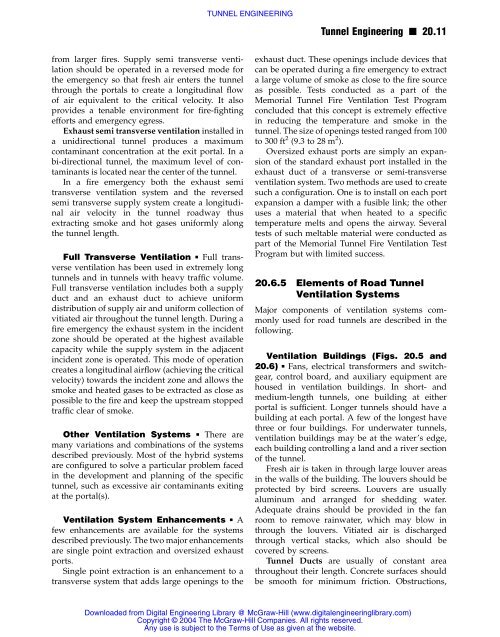TUNNEL ENGINEERING
TUNNEL ENGINEERING
TUNNEL ENGINEERING
Create successful ePaper yourself
Turn your PDF publications into a flip-book with our unique Google optimized e-Paper software.
from larger fires. Supply semi transverse ventilation<br />
should be operated in a reversed mode for<br />
the emergency so that fresh air enters the tunnel<br />
through the portals to create a longitudinal flow<br />
of air equivalent to the critical velocity. It also<br />
provides a tenable environment for fire-fighting<br />
efforts and emergency egress.<br />
Exhaust semi transverse ventilation installed in<br />
a unidirectional tunnel produces a maximum<br />
contaminant concentration at the exit portal. In a<br />
bi-directional tunnel, the maximum level of contaminants<br />
is located near the center of the tunnel.<br />
In a fire emergency both the exhaust semi<br />
transverse ventilation system and the reversed<br />
semi transverse supply system create a longitudinal<br />
air velocity in the tunnel roadway thus<br />
extracting smoke and hot gases uniformly along<br />
the tunnel length.<br />
Full Transverse Ventilation n Full transverse<br />
ventilation has been used in extremely long<br />
tunnels and in tunnels with heavy traffic volume.<br />
Full transverse ventilation includes both a supply<br />
duct and an exhaust duct to achieve uniform<br />
distribution of supply air and uniform collection of<br />
vitiated air throughout the tunnel length. During a<br />
fire emergency the exhaust system in the incident<br />
zone should be operated at the highest available<br />
capacity while the supply system in the adjacent<br />
incident zone is operated. This mode of operation<br />
creates a longitudinal airflow (achieving the critical<br />
velocity) towards the incident zone and allows the<br />
smoke and heated gases to be extracted as close as<br />
possible to the fire and keep the upstream stopped<br />
traffic clear of smoke.<br />
Other Ventilation Systems n There are<br />
many variations and combinations of the systems<br />
described previously. Most of the hybrid systems<br />
are configured to solve a particular problem faced<br />
in the development and planning of the specific<br />
tunnel, such as excessive air contaminants exiting<br />
at the portal(s).<br />
Ventilation System Enhancements n A<br />
few enhancements are available for the systems<br />
described previously. The two major enhancements<br />
are single point extraction and oversized exhaust<br />
ports.<br />
Single point extraction is an enhancement to a<br />
transverse system that adds large openings to the<br />
<strong>TUNNEL</strong> <strong>ENGINEERING</strong><br />
Tunnel Engineering n 20.11<br />
exhaust duct. These openings include devices that<br />
can be operated during a fire emergency to extract<br />
a large volume of smoke as close to the fire source<br />
as possible. Tests conducted as a part of the<br />
Memorial Tunnel Fire Ventilation Test Program<br />
concluded that this concept is extremely effective<br />
in reducing the temperature and smoke in the<br />
tunnel. The size of openings tested ranged from 100<br />
to 300 ft 2 (9.3 to 28 m 2 ).<br />
Oversized exhaust ports are simply an expansion<br />
of the standard exhaust port installed in the<br />
exhaust duct of a transverse or semi-transverse<br />
ventilation system. Two methods are used to create<br />
such a configuration. One is to install on each port<br />
expansion a damper with a fusible link; the other<br />
uses a material that when heated to a specific<br />
temperature melts and opens the airway. Several<br />
tests of such meltable material were conducted as<br />
part of the Memorial Tunnel Fire Ventilation Test<br />
Program but with limited success.<br />
20.6.5 Elements of Road Tunnel<br />
Ventilation Systems<br />
Major components of ventilation systems commonly<br />
used for road tunnels are described in the<br />
following.<br />
Ventilation Buildings (Figs. 20.5 and<br />
20.6) n Fans, electrical transformers and switchgear,<br />
control board, and auxiliary equipment are<br />
housed in ventilation buildings. In short- and<br />
medium-length tunnels, one building at either<br />
portal is sufficient. Longer tunnels should have a<br />
building at each portal. A few of the longest have<br />
three or four buildings. For underwater tunnels,<br />
ventilation buildings may be at the water’s edge,<br />
each building controlling a land and a river section<br />
of the tunnel.<br />
Fresh air is taken in through large louver areas<br />
in the walls of the building. The louvers should be<br />
protected by bird screens. Louvers are usually<br />
aluminum and arranged for shedding water.<br />
Adequate drains should be provided in the fan<br />
room to remove rainwater, which may blow in<br />
through the louvers. Vitiated air is discharged<br />
through vertical stacks, which also should be<br />
covered by screens.<br />
Tunnel Ducts are usually of constant area<br />
throughout their length. Concrete surfaces should<br />
be smooth for minimum friction. Obstructions,<br />
Downloaded from Digital Engineering Library @ McGraw-Hill (www.digitalengineeringlibrary.com)<br />
Copyright © 2004 The McGraw-Hill Companies. All rights reserved.<br />
Any use is subject to the Terms of Use as given at the website.
















